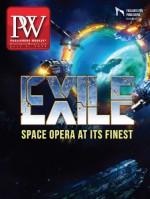In The Dinosaur Artist: Obsession, Betrayal, and the Quest for Earth’s Ultimate Trophy (Hachette, Sept.; reviewed on p. 60), New Yorker writer Williams illuminates the world of commercial fossil hunters.
What drew you to this story?
In the spring of 2012 a Google alert surfaced about an upcoming New York City auction that the Mongolian government was trying to stop. One of the sellers was Eric Prokopi, a young, well-educated Florida guy with a wife and two small children; he had spent his life as a fossil hunter and recently had decided to deal in dinosaurs, a move some in the [fossil hunting and dealing] trade saw as an incredibly risky choice and the kind of business that paleontologists generally consider a grave detriment to science and wish didn’t exist. The combination of successful New York auction house, obscure Florida family man and fossil dealer, and a dinosaur skeleton from the Gobi Desert felt like a story worth telling: you had the auction and museum industries, the controversial fossil trade, and the story of a family trying to make a life on extremely old bones. The question became just how far Prokopi would go to build and sustain that life. And the case became even more interesting once it turned criminal.
What did you learn that you hadn’t expected?
I was struck by the depth of devotion supposedly amateur fossil hunters show toward their work, and the level of professionalism with which most approach their work. Fossil fanatics are true seekers—they spend long, hot, uncomfortable, and sometimes fruitless hours and days searching for the object of their desire, hoping to build or complete a collection. It’s a global community whose members are some of the most devoted, colorful people you’ll meet, who are often as enraptured by the science as by the hunt. It also surprised me that the fossil trade has become a focus for federal law enforcement, who came to understand the inevitable shadier side of the industry through the Prokopi case.
How was putting this book together different from your other long-form nonfiction?
There were many more moving parts because the reporting lasted longer. The book’s structure was also a bit difficult to figure out because the story is an amalgam of interconnected stories that moved back and forth in time, and across continents, with different but related characters. Sometimes the main character disappeared for over a hundred pages. The story had to hold together, though, as a piece—it had to dovetail. It delighted me, during the reporting, to discover that this would even be possible. Complexity is fun, as is figuring out what a particular story means on a larger scale. In this case, we’re talking about the extreme importance of fossils, which are fundamental to our understanding of the past and future of planet Earth.



 Volume 265
Issue 27
07/02/2018
Volume 265
Issue 27
07/02/2018





